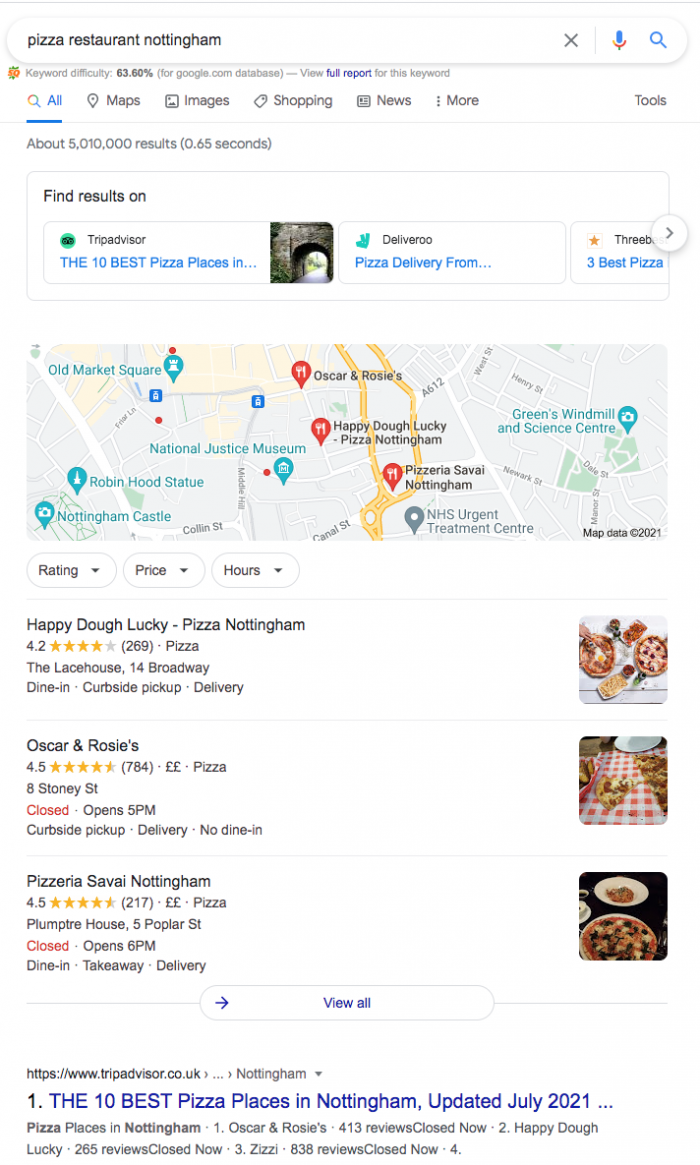Local SEO is all about optimising your website for ‘location specific’ searches. This is great for local businesses and websites with brick-and-mortar shops. On the surface, local SEO uses the searcher’s location when searching to provide them with results that are nearby. So when you’re out and about and looking for somewhere to grab a bite to eat, all you need to do is search and you will find listings located by distance.
How does Local SEO work?
Local search relies on two key areas to provide users with information about your site. These are your website’s information used on organic search results and Google My Business (GMB). Search engines will scour the internet to return businesses and services relevant to a specific location. So if you register your business address and list the details of it on your contact page and other locations, then chances are when someone searches for your services in the local area your name will pop up.
Local search also consists of localised paid ads that use targeted location keywords to shoot your name to the top of the SERP results for some quick results.
How does Local SEO look on SERPs?
Typically, when searching for a service in an area; for example ‘pizza restaurant Nottingham’ you’ll find the listings broken down into 3 key areas. At the top, you’ll find a map with pins to tap and direct to. Underneath that block, you’ll find the ‘Local Pack’, a rich snippet that lists GMB listings with a title, ratings, images, and key USPs. Finally, organic results are listed below that.

This makes local search a highly competitive space where getting your name on the local pack using GMB can get you a higher spot than first on organic search.
Google My Business
GMB is key to local SEO success, not just for rankings but also for ease of use and capturing rich snippets. By setting up GMB you can add highly visible branding and information on search results for your brand or website. In this way, you can reduce the number of steps required for users to reach your site leading to easier bookings, quote requests, and information gathering.
Now while determining factors are all very secretive at Google there are a few ways to optimise your GMB listing to rank for search terms. They are:
Relevance – “Relevance refers to how well a local Business Profile matches what someone is searching for. Add complete and detailed business information to help Google better understand your business and match your profile to relevant searches.”
Distance – “Distance considers how far each potential search result is from the location term used in a search. If a user doesn’t specify a location in their search, we’ll calculate distance based on what we do know about their location.”
Prominence – “Prominence refers to how well known a business is. Some places are more prominent in the offline world, and search results try to reflect this in local ranking. For example, famous museums, landmark hotels, or well-known store brands are also likely to be prominent in local search results.”
As you can see the factors are quite vague but these definitions give you an idea of what needs to go into a local listing. If you’d like a hand with this process then trust the professionals. Our SEO team at Fifteen are well-versed in all things SEO and optimise sites to promote higher rankings, more efficient keyword capture, and increased conversions. Contact us today to find out more and we’ll help you make the most of local SEO.
